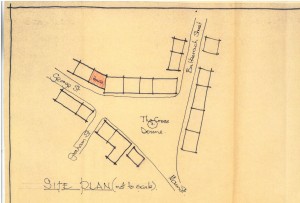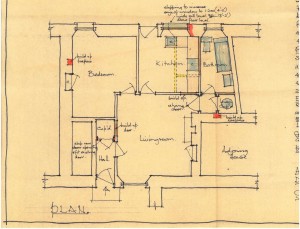When visitors to the village of Doune, or indeed residents of the village walk passed a row of terraced cottages 1 – 11 George Street, often they will mistake the buildings as a Charles Rennie MacIntosh design. However they would be forgiven as Charles Rennie MacIntosh is believed to have been inspired by the gentleman who did design the cottages, with his own architectural influence.
The gentleman in question was Thomas MacLaren, born and raised in nearby Thornhill. The son of a farmer, Thomas was the youngest of eleven children (although sadly not all lived to adulthood), along with his elder better known brother James MacLaren became architects. Thomas began his architectural training at the age of 17, when he served as a apprentice in an architectural practice in London, from there his career spanned from England to Italy to Switzerland (this was most likely due to his respiratory health problems he had during most of his life). He set up his own independent practice in March 1899 in London as “M’Laren and M’Niven of London”.
Prior 1894, George Street was originally called Pudden Wynd, due to the abundance of butcher shops that sold black and white puddings. In 1893, along with various other streets in the burgh, the street was renamed as Chapel Street, due to the Episcopal Church and the Wesleyan Methodist Chapel both located on the street, however later in the year in December 1893 the street was further renamed as George Street.[1]
Unlike most streets in the UK that are called George Street named after the Georgian monarchs, George Street, Doune was named after the beneficiary of the construction of the swiss style cottages, Revd. George Sutherland MacKay, Minister of the Free Church of Scotland. Revd MacKay was at the time of his death in 1912 a very affluent man, his estate amounted to £26, 411, 4s 5d (over £1 million in today’s currency) and seems to have a philantrophic interest in the working class residents of the burgh. However after an article was published in December 1893 by the Stirling Saturday Observer, it may be argued that not everyone agreed with MacKay for his philantrophic interests for the working class and MacLaren’s architectural style:
“The handsome building at the south west entrance to the Burgh is after the Swiss style of architectureand gives accomodation to six families and with the new building opposite, the property of the late Bailie Bain, has much improved the locality in which it is situated but a less ornamental structure would have met the requirements of the case equally well as, if the rental is at all in keeping with the cost of construction, about £2000, it wil be beyond the means of ordinary working men in the district to occupy. With the finishing touches on these new buildings however the prospect is anything but cheering for the future.”
1-11 George Street were to be the only buildings designed by Thomas MacLaren in Scotland, he career eventually took him to the United States where he gained citizenship in 1903 and he died in Denver, Colorado in 1928.[2]
[1] For more information about Doune and its surrounding area, refer to Doune Historical Notes, M S MacKay (Revd. MacKay’s son).
[2] For further information about Thomas MacLaren and James. M. MacLaren, it is worth contacting the James. M. MacLaren Society.
This post was written by Stirling Archives volunteer Darren Ferrier.

